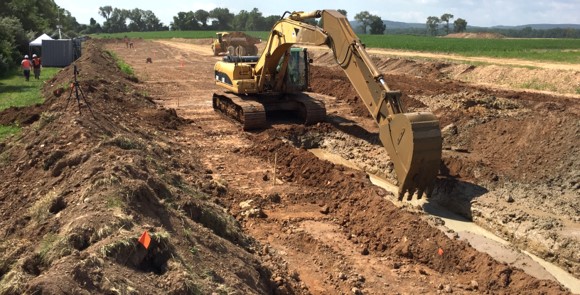About
Soil-bentonite slurry trench cutoff walls have been used for over 50 years to control groundwater flow and contaminant transport. Studies have shown that 1) the stresses in the backfill are anisotropic and dependent upon load transfer from soil-bentonite backfill to trench sidewalls as the backfill consolidates and settles, 2) the hydraulic conductivity of soil-bentonite backfill is stress-dependent, and 3) the rate of consolidation is controlled by the fluid flow out of the backfill into the formation.
These phenomena are time-dependent and affected by the various stages of slurry trench construction including excavation, backfilling, backfill consolidation, and long-term backfill secondary compression (creep).
During the summer of 2016, a full-scale soil-bentonite slurry trench cutoff wall was constructed to evaluate the above phenomena. The wall was instrumented with four pairs of inclinometers, four settlement plates, and four sets of earth pressure cells to measure total stresses in the backfill in three dimensions (i.e., vertical, horizontal longitudinal, and horizontal transverse) at four different locations within the wall. Each set of earth pressure cells was mounted on a cage with an accompanying pressure transducer to measure pore pressure, a thermistor to measure temperature and sensors to measure tilt and roll (position). The sensors and data collection system installed during construction have continued to function, record, and transmit data continuously since construction. This presentation summarizes the findings from the monitoring of the instrumented soil-bentonite wall.
The study showed that the primary consolidation was completed approximately two weeks after wall construction. However, coupled phenomena consisting of lateral deformation, backfill settlement, pore pressure dissipation, and load transfer were still occurring six years after wall construction. With the ability to examine this extended data set, it is found that long-term secondary compression, both vertically and transversely resulted in load transfer between the backfill and the sidewalls and is still occurring six years after completion of wall construction. Since secondary compression is a logarithmic function, the rate of change is constantly decreasing.
After six years, effective stresses remain far below geostatic. The maximum stresses are those stresses transverse to the axis of the trench from the impact of lateral deformations. The lowest stresses are the vertical stresses, reflecting the impact of arching or side wall friction as the soft backfill moves downward within the trench. Longitudinal horizontal stresses are intermediate between the transverse horizontal stresses and vertical stresses.
Presenter
Professor Emeritus Jeffrey Evans, Bucknell University
Dr Jeffrey Evans is Professor Emeritus of Civil and Environmental Engineering at Bucknell University, Lewisburg, PA. He earned BSCE, MSCE and Ph.D. degrees in Civil Engineering from Clarkson University, Purdue University, and Lehigh University, respectively. He joined Bucknell University in 1985 where honors included the Class of ’56 Lectureship (1997) for inspirational teaching, and Presidential Professor (2001) for contributions to the University. In 2012 he was named Overseas Fellow at Cambridge University (Churchill College). He has been a visiting academic at Cambridge University (2012-13) and the University of Nottingham (1998-99) and a Senior Scientific Officer (1991-92) at the Warren Spring Laboratory, all in the UK. Before joining Bucknell, he spent over 10 years as a consultant with Woodward-Clyde Consultants (now AECOM) where he was named “Young Professional of the Year” in 1984. His experience also includes the U.S. Army Corps of Engineers Reserves where he served as a 2nd Lieutenant, 1st Lieutenant, and Captain. He has also authored and co-authored over 100 publications in the areas of geotechnical, ground improvement and geoenvironmental engineering. He has also co-authored three books (Hazardous Waste Management, Fundamentals of Ground Improvement and Slurry Trenching: History, Uses, Fundamentals and Construction) along with Chapters in eight other books.



![2nd John Burland Lecture: Reflections on Some Contemporary Aspects of Geotechnical Engineering Education - From Critical State to Virtual Immersion {"category":"webinar","subjects":["Education"],"number":"GEE2020-1","instructors":["Mark Jaksa"]}](/asset-v1:ISSMGE+GEE2020_1+2020+type@asset+block@Jaksa-Intro-Slide.jpg)
![Forks in the Road: Rethinking Modeling Decisions that Defined Teaching and Practice of Geotechnical Engineering {"category":"webinar","subjects":["Education"],"number":"GEE2020-2","instructors":["Rodrigo Salgado"]}](/asset-v1:ISSMGE+GEE2020_2+2020+type@asset+block@Salgado-Intro-Slide.jpg)
![Prior Knowledge, Learning and Common Instructional Practices Grounded in Evidence {"category":"webinar","subjects":["Education"],"number":"GEE2020-3","instructors":["Susan A. Ambrose"]}](/asset-v1:ISSMGE+GEE2020_3+2020+type@asset+block@Ambrose-Intro-Slide.jpg)
![Basic Geotechnical Engineering Skills What Can Graduated Do? (First John Burland Lecture) {"category":"honour_lecture","subjects":["Education"],"number":"HJBL101","instructors":["John Atkinson"]}](/asset-v1:ISSMGE+HJBL101+2016+type@asset+block@1475823575-John-Atkinson-Webinar.jpg)
![3rd John Burland Lecture | Changing attitudes, organization and scale in engineering education: The teacher as a go-between and TC306 as a knowledge broker {"category":"honour_lecture","subjects":["Education", "Teaching Geotechnics"],"number":"TC306-GEE2025-01","instructors":["Marina Pantazidou"]}](/asset-v1:ISSMGE+TC306-GEE2025-01+2025+type@asset+block@pantazidou.png)
![Urgent questions for engineering education in the age of GenAI: knowledge, teaching, & assessment {"category":"honour_lecture","subjects":["Education"],"number":"TC306-GEE2025-02","instructors":["Jennifer Case"]}](/asset-v1:ISSMGE+TC306-GEE2025-02+2025+type@asset+block@case.png)
![New challenges in rock mechanics: Building new skills in engineering education {"category":"talk","subjects":["Education"],"number":"TC306-GEE2025-04","instructors":["Jean Sulem"]}](/asset-v1:ISSMGE+TC306-GEE2025-04+2025+type@asset+block@sulem.png)
![What role should software play in geotechnical education? {"category":"talk","subjects":["Education", "Numerical Analysis"],"number":"TC306-GEE2025-06","instructors":["Nicolas Utter"]}](/asset-v1:ISSMGE+TC306-GEE2025-06+2025+type@asset+block@utter.png)
![Geosynthetics in the Classroom: Educating Future Engineers and Their Instructors {"category":"honour_lecture","subjects":["Education", "Teaching Geotechnics"],"number":"TC306-GEE2025-07","instructors":["Jorge G. Zornberg"]}](/asset-v1:ISSMGE+TC306-GEE2025-07+2025+type@asset+block@zornberg.png)